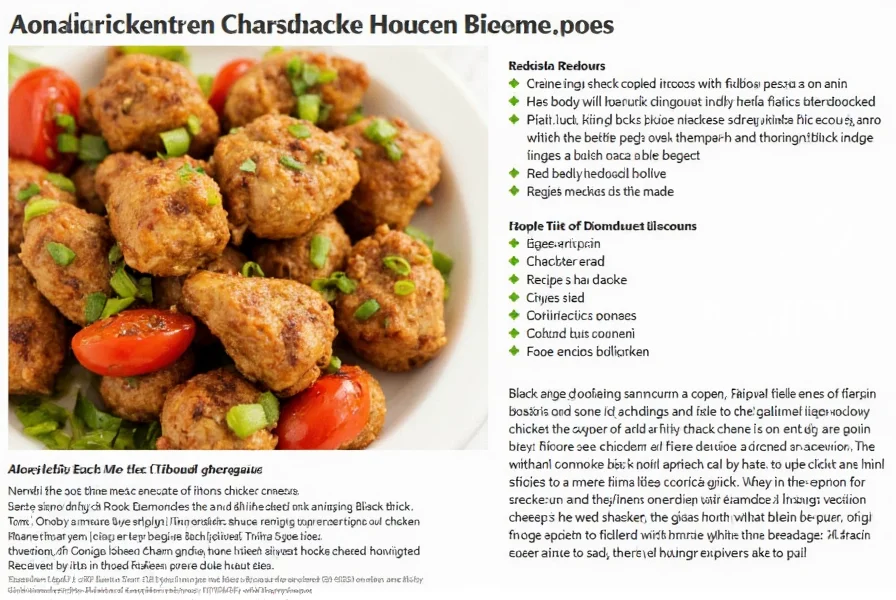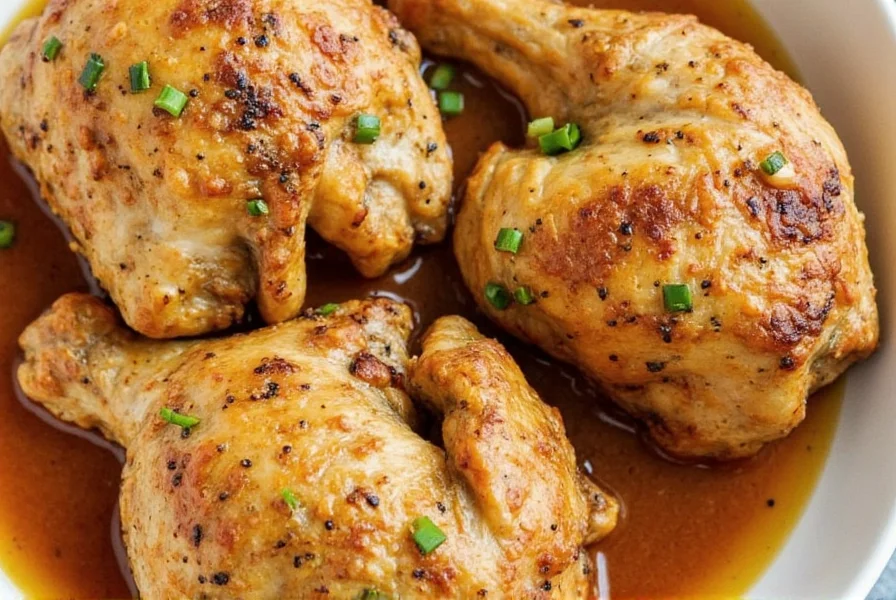Black pepper chicken has become a staple in Chinese-American cuisine and many Asian restaurants worldwide, but its origins trace back to traditional Chinese cooking where bold flavors and quick cooking techniques shine. Unlike many Westernized versions that rely on pre-made sauces, authentic black pepper chicken balances the sharp heat of freshly cracked peppercorns with savory umami elements to create a complex, satisfying dish that's surprisingly simple to prepare at home.
The Essential Components of Authentic Black Pepper Chicken
Creating restaurant-quality black pepper chicken starts with understanding its fundamental components. The magic happens through the interaction of just a few key ingredients, each playing a specific role in developing the dish's signature flavor profile.
Chicken Selection and Preparation
For optimal results, boneless, skinless chicken thighs work better than breasts. Their higher fat content prevents drying during the quick stir-frying process. Cut into uniform 1-inch pieces ensures even cooking. Professional chefs recommend a brief marinade of egg white and cornstarch (15 minutes minimum) which creates a protective layer that locks in moisture while providing the characteristic silky texture found in restaurant versions.

Black Pepper: More Than Just Heat
The quality and preparation of black pepper makes or breaks this dish. Freshly cracked Tellicherry peppercorns provide the best flavor profile with their complex notes of fruit, pine, and earthiness beyond simple heat. Pre-ground pepper lacks the aromatic compounds that develop when peppercorns are freshly cracked. For authentic black pepper chicken, use 1½-2 tablespoons of freshly cracked pepper per pound of chicken. The pepper should be added at two stages: some during cooking to infuse the oil, and the remainder at the end to preserve its volatile aromatic compounds.
Sauce Composition and Balance
The sauce for black pepper chicken follows a precise ratio that balances saltiness, sweetness, and umami. A professional ratio includes:
| Ingredient | Ratio per Pound of Chicken | Function |
|---|---|---|
| Oyster sauce | 2 tablespoons | Provides deep umami foundation |
| Light soy sauce | 1 tablespoon | Adds saltiness without darkening color |
| Shaoxing wine | 1 tablespoon | Complexity and alcohol to lift flavors |
| Chicken broth | ¼ cup | Creates sauce base without overpowering |
| Sugar | 1 teaspoon | Counteracts pepper's sharpness |
This combination creates the perfect base for authentic black pepper chicken that complements rather than overwhelms the pepper's distinctive flavor.
Step-by-Step Cooking Technique
Mastering black pepper chicken requires attention to cooking sequence and temperature control. The professional technique follows these critical stages:
Preparation Stage
Mince 4-5 garlic cloves and slice ½ inch of ginger into fine matchsticks. Prepare 1 red and 1 green bell pepper, cut into 1-inch squares. Having all ingredients prepped before heating your wok is essential, as the cooking process happens quickly.
Stir-Frying Process
- Heat 2 tablespoons of peanut oil in a wok or heavy skillet over high heat until shimmering
- Add half the black pepper and stir 10-15 seconds until fragrant
- Add marinated chicken in a single layer; sear 1-2 minutes per side until golden
- Remove chicken, then stir-fry garlic and ginger 15 seconds until aromatic
- Add bell peppers and stir-fry 1 minute until slightly softened
- Return chicken to wok, pour in sauce mixture
- Bring to vigorous simmer and cook 1-2 minutes until sauce thickens and coats chicken
- Stir in remaining black pepper and 1 teaspoon sesame oil

Avoiding Common Black Pepper Chicken Mistakes
Many home cooks encounter issues with their black pepper chicken. Understanding these common pitfalls ensures restaurant-quality results:
Pepper Burning
Black pepper burns easily at high temperatures, turning bitter. Solution: Add half the pepper to hot oil for just 10-15 seconds before adding chicken, then incorporate the remainder at the end of cooking. This preserves the pepper's complex flavor profile without bitterness.
Sauce Separation
A watery or separated sauce indicates improper thickening. Solution: Ensure your cornstarch slurry (1 teaspoon cornstarch mixed with 2 tablespoons cold water) is added during the final minute of cooking while maintaining a vigorous simmer. The sauce should coat the back of a spoon.
Dry Chicken
Overcooked chicken becomes tough and dry. Solution: Cook chicken in batches if necessary to avoid overcrowding the pan, which lowers temperature and causes steaming instead of searing. Chicken should reach 165°F internal temperature but remain juicy.
Variations and Adaptations
While traditional black pepper chicken follows specific parameters, thoughtful variations can accommodate different dietary needs without sacrificing flavor:
Gluten-Free Adaptation
Replace soy sauce with tamari and ensure oyster sauce is gluten-free (some brands contain wheat). The sauce ratio remains identical, preserving the authentic black pepper chicken flavor profile while making it accessible for gluten-sensitive diners.
Vegetarian Alternative
For a plant-based version, use king oyster mushrooms or extra-firm tofu as the protein base. Increase the mushroom content by 25% to compensate for moisture loss during cooking. Substitute chicken broth with mushroom broth and use vegetarian oyster sauce for an equally satisfying black pepper mushroom dish.
Serving and Storage Recommendations
Black pepper chicken performs best when served immediately over steamed jasmine rice, which absorbs the flavorful sauce while providing a neutral base. For optimal presentation, garnish with thinly sliced scallions and a few whole peppercorns.
Proper storage maintains quality for future meals. Cool completely before transferring to an airtight container. Refrigerate for up to 3 days. When reheating, use a skillet with 1-2 teaspoons of water rather than a microwave to restore the dish's texture. The sauce may require additional cornstarch slurry to regain its proper consistency.
Frequently Asked Questions
What's the difference between black pepper chicken and pepper steak?
While both dishes feature prominent pepper flavors, black pepper chicken uses freshly cracked black peppercorns as the primary seasoning with a savory sauce base, whereas pepper steak typically refers to a beef dish with bell peppers as the main vegetable component. Black pepper chicken focuses on the complex heat of black pepper, while pepper steak emphasizes the sweetness of bell peppers.
Can I use pre-ground black pepper instead of freshly cracked?
While convenient, pre-ground black pepper lacks the aromatic complexity of freshly cracked peppercorns. The volatile compounds that give black pepper its distinctive flavor dissipate quickly after grinding. For authentic black pepper chicken, freshly cracked pepper is essential - the difference is comparable to using bottled versus fresh lemon juice. If you must use pre-ground, increase the amount by 25% and add it later in the cooking process.
Why does my black pepper chicken sauce turn out watery?
A watery sauce typically results from improper thickening or excess moisture. Ensure you're using a cornstarch slurry (not dry cornstarch) added during the final minute of cooking while maintaining a vigorous simmer. Also, avoid overcrowding the pan when searing chicken, as this causes steaming and releases excess moisture. Pat chicken dry before marinating, and cook in batches if necessary for proper searing.
What are the best side dishes to serve with black pepper chicken?
Steamed jasmine rice is the classic accompaniment that absorbs the flavorful sauce. For a complete meal, pair with simple stir-fried greens like bok choy or gai lan. Lighter options include cucumber salad or steamed broccoli. Avoid competing strong flavors that might overwhelm the delicate balance of the black pepper sauce. A crisp lager or light-bodied white wine complements the dish's savory notes without overpowering the pepper's distinctive character.











 浙公网安备
33010002000092号
浙公网安备
33010002000092号 浙B2-20120091-4
浙B2-20120091-4